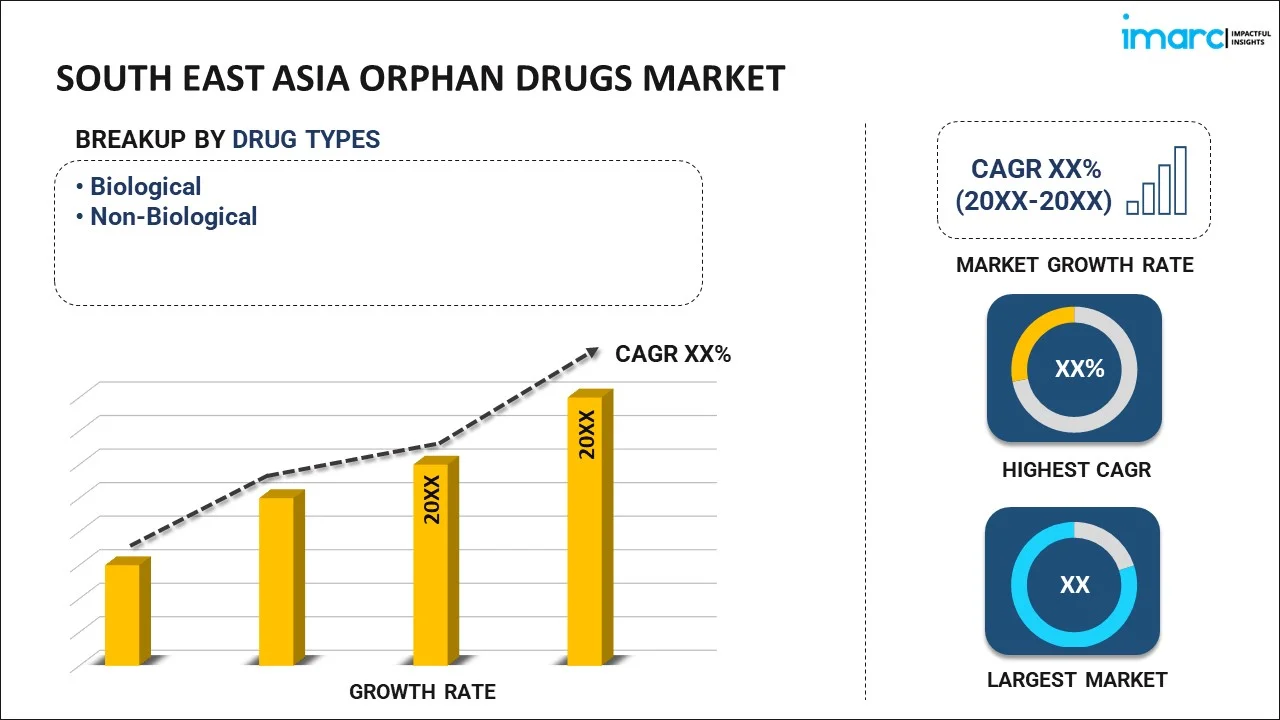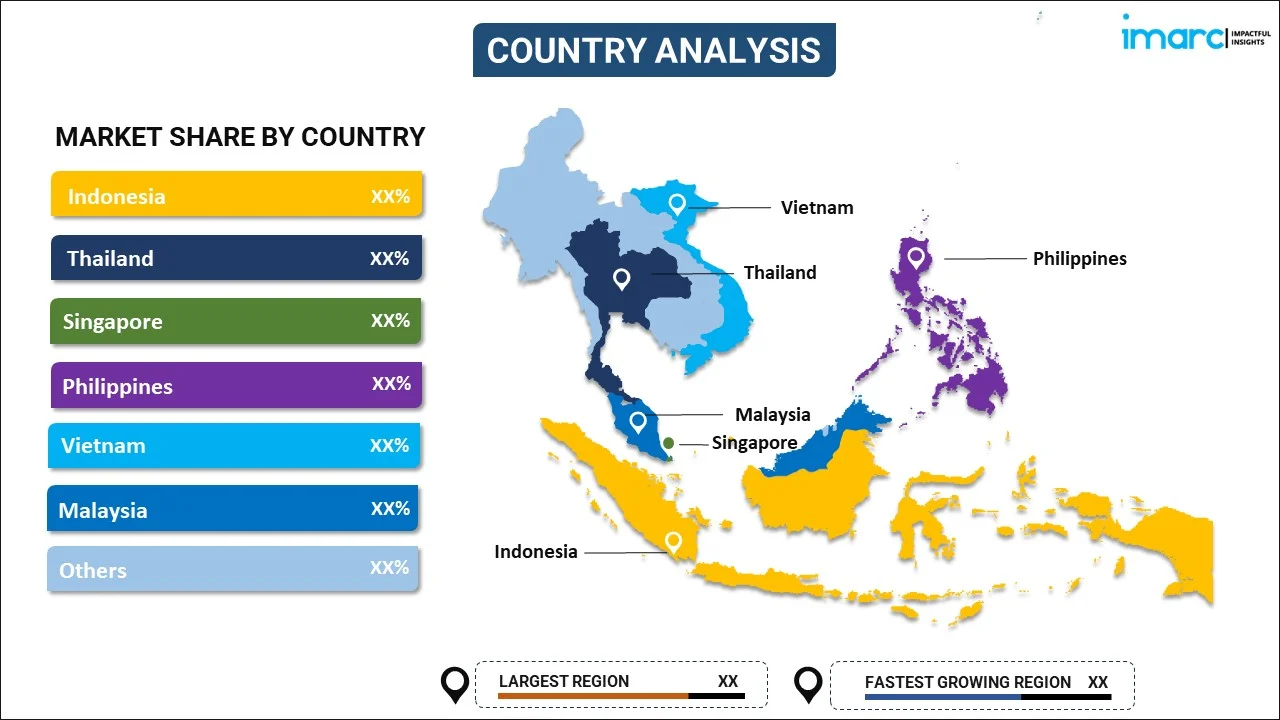
South East Asia Orphan Drugs Market Report by Drug Type (Biological, Non-Biological), Disease Type (Oncology, Hematology, Neurology, Cardiovascular, and Others), Phase (Phase I, Phase II, Phase III, Phase IV), Top Selling Drugs (Revlimid, Rituxan, Copaxone, Opdivo, Keytruda, Imbruvica, Avonex, Sensipar, Soliris, and Others), Distribution Channel (Hospital Pharmacies, Retail Pharmacies, Online Stores, and Others), and Country 2024-2032
Market Overview:
South East Asia orphan drugs market size is projected to exhibit a growth rate (CAGR) of XX% during 2024-2032. The widespread adoption of these specialized pharmaceutical products that cater to the unique health requirements of individuals facing rare diseases, offering targeted solutions for conditions that often lack mainstream treatment options, is primarily driving the market growth.
|
Report Attribute
|
Key Statistics
|
|---|---|
|
Base Year
|
2023 |
|
Forecast Years
|
2024-2032
|
|
Historical Years
|
2018-2023
|
| Market Growth Rate (2024-2032) | XX% |
Orphan drugs pertain to pharmaceutical products designed for the diagnosis, prevention, and treatment of rare medical conditions. These medications are formulated to address a distinct public health need and typically have a restricted market, catering to a small patient population. They prove efficacious in combating various rare diseases spanning oncological, metabolic, hematologic, immunologic, infectious, and neurological categories. Conditions such as lymphoma, leukemia, cystic fibrosis, glioma, pancreatic cancer, ovarian cancer, multiple myeloma, and renal cell carcinoma fall under the umbrella of orphan diseases. Frequently, these ailments are characterized by their life-threatening, chronic, progressive, degenerative, and disabling nature, necessitating specific treatment options tailored to address their unique symptoms.
South East Asia Orphan Drugs Market Trends:
The South East Asia orphan drugs market has emerged as a critical component of the region's healthcare landscape, addressing the specific needs of patients grappling with rare medical disorders. This region, encompassing countries, such as Thailand, Indonesia, Malaysia, Vietnam, and Singapore, has witnessed a growing awareness and recognition of the importance of orphan drugs in healthcare. The market's emphasis on orphan drugs aligns with the global effort to address neglected medical conditions, acknowledging the challenges faced by patients with diseases that fall outside the realm of common ailments. In South East Asia, orphan drugs prove to be particularly effective against a spectrum of rare diseases, including oncological, metabolic, hematologic, immunologic, infectious, and neurological disorders. Conditions such as rare forms of cancer, genetic disorders, and autoimmune diseases are among the focus areas where orphan drugs demonstrate significant impact. Furthermore, there is a growing realization of the importance of ensuring access to these treatments for affected individuals, which is catalyzing the regional market. Efforts are underway to address regulatory and economic challenges associated with orphan drugs, aiming to make these therapies more accessible to patients in need. This, in turn, is expected to fuel the market growth over the forecasted period.
South East Asia Orphan Drugs Market Segmentation:
IMARC Group provides an analysis of the key trends in each segment of the market, along with forecasts at the regional and country level for 2024-2032. Our report has categorized the market based on drug type, disease type, phase, top selling drugs, and distribution channel.
Drug Type Insights:

- Biological
- Non-Biological
The report has provided a detailed breakup and analysis of the market based on the drug type. This includes biological and non-biological.
Disease Type Insights:
- Oncology
- Hematology
- Neurology
- Cardiovascular
- Others
A detailed breakup and analysis of the market based on the disease type have also been provided in the report. This includes oncology, hematology, neurology, cardiovascular, and others.
Phase Insights:
- Phase I
- Phase II
- Phase III
- Phase IV
The report has provided a detailed breakup and analysis of the market based on the phase. This includes phase I, phase II, phase III, and phase IV.
Top Selling Drugs Insights:
- Revlimid
- Rituxan
- Copaxone
- Opdivo
- Keytruda
- Imbruvica
- Avonex
- Sensipar
- Soliris
- Others
A detailed breakup and analysis of the market based on the top selling drugs have also been provided in the report. This includes revlimid, rituxan, copaxone, opdivo, keytruda, imbruvica, avonex, sensipar, soliris, and others.
Distribution Channel Insights:
- Hospital Pharmacies
- Retail Pharmacies
- Online Stores
- Others
The report has provided a detailed breakup and analysis of the market based on the distribution channel. This includes hospital pharmacies, retail pharmacies, online stores, and others.
Country Insights:

- Indonesia
- Thailand
- Singapore
- Philippines
- Vietnam
- Malaysia
- Others
The report has also provided a comprehensive analysis of all the major regional markets, which include Indonesia, Thailand, Singapore, Philippines, Vietnam, Malaysia, and Others.
Competitive Landscape:
The market research report has also provided a comprehensive analysis of the competitive landscape in the market. Competitive analysis such as market structure, key player positioning, top winning strategies, competitive dashboard, and company evaluation quadrant has been covered in the report. Also, detailed profiles of all major companies have been provided.
South East Asia Orphan Drugs Market Report Coverage:
| Report Features | Details |
|---|---|
| Base Year of the Analysis | 2023 |
| Historical Period | 2018-2023 |
| Forecast Period | 2024-2032 |
| Units | US$ Million |
| Scope of the Report | Exploration of Historical and Forecast Trends, Industry Catalysts and Challenges, Segment-Wise Historical and Predictive Market Assessment:
|
| Drug Types Covered | Biological, Non-Biological |
| Disease Types Covered | Oncology, Hematology, Neurology, Cardiovascular, Others |
| Phases Covered | Phase I, Phase II, Phase III, Phase IV |
| Top Selling Drugs Covered | Revlimid, Rituxan, Copaxone, Opdivo, Keytruda, Imbruvica, Avonex, Sensipar, Soliris, Others |
| Distribution Channels Covered | Hospital Pharmacies, Retail Pharmacies, Online Stores, Others |
| Countries Covered | Indonesia, Thailand, Singapore, Philippines, Vietnam, Malaysia, Others |
| Customization Scope | 10% Free Customization |
| Report Price and Purchase Option | Single User License: US$ 3699 Five User License: US$ 4699 Corporate License: US$ 5699 |
| Post-Sale Analyst Support | 10-12 Weeks |
| Delivery Format | PDF and Excel through Email (We can also provide the editable version of the report in PPT/Word format on special request) |
Key Questions Answered in This Report:
- How has the South East Asia orphan drugs market performed so far and how will it perform in the coming years?
- What has been the impact of COVID-19 on the South East Asia orphan drugs market?
- What is the breakup of the South East Asia orphan drugs market on the basis of drug type?
- What is the breakup of the South East Asia orphan drugs market on the basis of disease type?
- What is the breakup of the South East Asia orphan drugs market on the basis of phase?
- What is the breakup of the South East Asia orphan drugs market on the basis of top selling drugs?
- What is the breakup of the South East Asia orphan drugs market on the basis of distribution channel?
- What are the various stages in the value chain of the South East Asia orphan drugs market?
- What are the key driving factors and challenges in the South East Asia orphan drugs?
- What is the structure of the South East Asia orphan drugs market and who are the key players?
- What is the degree of competition in the South East Asia orphan drugs market?
Key Benefits for Stakeholders:
- IMARC’s industry report offers a comprehensive quantitative analysis of various market segments, historical and current market trends, market forecasts, and dynamics of the South East Asia orphan drugs market from 2018-2032.
- The research report provides the latest information on the market drivers, challenges, and opportunities in the South East Asia orphan drugs market.
- Porter's five forces analysis assist stakeholders in assessing the impact of new entrants, competitive rivalry, supplier power, buyer power, and the threat of substitution. It helps stakeholders to analyze the level of competition within the South East Asia orphan drugs industry and its attractiveness.
- Competitive landscape allows stakeholders to understand their competitive environment and provides an insight into the current positions of key players in the market.
Need more help?
- Speak to our experienced analysts for insights on the current market scenarios.
- Include additional segments and countries to customize the report as per your requirement.
- Gain an unparalleled competitive advantage in your domain by understanding how to utilize the report and positively impacting your operations and revenue.
- For further assistance, please connect with our analysts.
 Inquire Before Buying
Inquire Before Buying
 Speak to an Analyst
Speak to an Analyst
 Request Brochure
Request Brochure
 Request Customization
Request Customization




.webp)




.webp)












